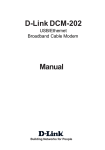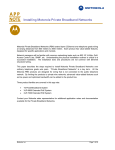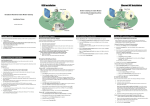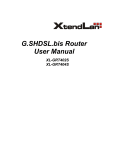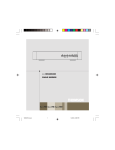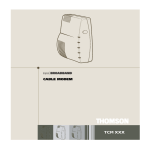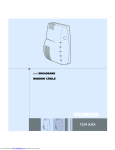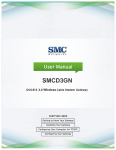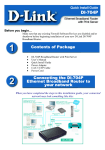Download D-Link DCM-201 Specifications
Transcript
D-Link DCM-201 USB/Ethernet Broadband Cable Modem Manual Building Networks for People Contents Package Contents ..................................................................3 System Requirements for Configuration...............................4 Local Cable Network Service .................................................5 Prepare Your Workspace for the Installation ........................5 Introduction .............................................................................7 Which Installation to Use? ......................................................8 Ethernet Installation ................................................................9 Troubleshooting the Ethernet Installation ........................... 12 USB Installation.................................................................... 15 Troubleshooting the USB Installation ................................. 27 Front and Rear Panels..........................................................30 LEDs ..................................................................................... 31 Back Panel Connectors ....................................................... 32 Technical Specifications ...................................................... 33 Technical Support ................................................................ 34 Warranty and Registration ................................................... 35 2 Package Contents Contents of Package: n D-Link DCM-201 USB/Ethernet Broadband Cable Modem n Manual, Warranty and Drivers on CD n Printed Quick Installation Guide n One 12VDC/1.25A Power adapter CAUTION! You must use the 12VDC/1.25A power adapter that comes with the D-Link DCM-201 cable modem. Using the wrong power adapter can damage the cable modem. n 1 CAT 5 UTP Ethernet cable n 1 USB cable n 1 Cable modem stand to install the cable modem in a vertical position If any of the above items are missing, please contact your reseller. CAUTION! Be sure to read this entire User Manual from front to back in sequence before installing the D-Link DCM-201 cable modem. 3 System Requirements for Configuration: Verify that you have these items before beginning the installation: n A cable-line splitter (not included), if you plan to have the cable modem and a television connected to the same wall cable outlet. n An active two-way cable line. n To install the cable modem using the Ethernet port: n n Any PC running Microsoft Windows 95, Windows 98, Windows Me, Windows 2000, Windows XP, or Windows NT operating systems or a computer running any other operating (OS) that supports the TCP/IP Internet protocol. n An active Ethernet port on your computer. n TCP/IP protocol installed. See the “Configuring the TCP/IP Communications Protocol” section for more information on installing the TCP/IP protocol. To install the cable modem using the USB port: n A PC running Windows XP, Windows 2000, or Windows Me operating system (OS). The USB drivers do not support the Macintosh operating system. n Original Windows 2000, or Windows ME installation CD or diskettes. n An active USB port on your computer 4 Local Cable Network Service Before installing the modem: 1 Read this entire User’s Manual from front to back in sequence. 2 Find the Serial Number, RF and Ethernet address located on a sticker on the cable modem and write them here: Serial Number S/N: ____________________ RF and ETH MAC: ____________________ USB MAC: ____________________ 3 Contact your local cable service operator for Internet/cable network access.Your local cable operator will check for cable access availability in your area, install a cable line (if necessary), provide you with an access account, set up configuration and verify other technical details. 4 Ask your local cable service provider about adding additional IP addresses to your account. See “ Which Installation to Use?” for more information. Prepare Your Workspace for the Cable Modem Installation Before installing the cable modem, you should prepare your workspace. You can install the cable modem vertically with the included bracket, or install the cable modem horizontally. To prepare your workspace: 1 Position the cable modem so that it is located near the computer and the wall cable outlet. There should be plenty of room to guide the cables away from the cable modem without crimping them. 2 Prepare the cable modem: n For vertical installation: Place the cable modem securely in the included stand. n For horizontal installation: Use the four included feet to install the cable modem. 5 Prepare Your Workspace for the Cable Modem Installation (continued) 3 Do not restrict the airflow around the cable modem. 4 To enhance the best performance and proper function of the cable modem, place it on a horizontal surface or workplace and make sure that the cable modem does not move when it is operating. 6 Introduction Thank you for purchasing the D-Link “Broadband Cable Modem with USB & Ethernet” DCM-201, which is an MCNS DOCSIS™ 1.1 cable modem featuring the latest DOCSIS technology. The cable modem enables your network cable operator to provide you with broadband applications such as telecommunications, IP dedication for your small office/home office (SOHO), or high-speed residential Internet access. The cable modem provides a downstream speed of up to 38 Mbps from the cable network to your computer and 10Mbps from your computer to the cable network. The DES data encryption helps ensure privacy for the transmitted information. Another distinctive feature of the cable modem is its easy installation, because DHCP and TFTP clients can obtain automatic access to the IP address and configuration from their network servers via the modem. SNMP agents permit remote configuration and monitoring from a management station equipped with an SNMP server. 7 Features n Full-featured compact, economical cable modem with Ethernet and USB ports n DOCSIS 1.1-compliant n Capable of handling downstream data transmission speeds up to 38Mbps; upstream to 10Mbps n RJ-45 10/100BaseT Ethernet port provides traditional industrystandard connection n USB port allows easy plug-and-play attachment to PCs with the latest Microsoft Windows operating system. n Extensive SNMP management support: MIB-II, n Ethernet-like MIB, Bridge MIB, Cable Device MIB, Baseline privacy Interface MIB, RF Interface MIB n Easy-to-read front panel LED’s clearly display network status and activity Decide Which Installation Process to Use The cable modem enables you to connect to the Internet using either your computer’s Ethernet or USB port. Be sure to follow the installation steps for the setup you want to use. Using the Ethernet setup enables you to use a hub to connect multiple computers to the cable modem. To do this, you might have to obtain additional IP addresses from your cable operator. Using the USB port enables you to install the cable modem more quickly and easily than connecting to the Internet using the Ethernet port, because you do not have to install a network interface card (NIC) into your computer. The USB port, however, only enables you to connect one computer to the cable modem. See “Installing the Cable Modem Using the Ethernet Port”, or see “Installing the Cable Modem Using the USB Port” in the following pages, for more information. 8 Installing the Cable Modem Using the Ethernet Port DCM-201 9 Installing the Cable Modem Using the Ethernet Port CAUTION! Be sure to read this entire User’s Manual from front to back in sequence before installing the D-Link DCM-201 USB/Ethernet Broadband Cable Modem. This chapter describes how to install the cable modem using the Ethernet port. Using the Ethernet port enables you to use a single connection to the Internet or use a hub to connect multiple computers to the cable modem. You can also use multiple IP addresses from your cable operator when using the Ethernet connection. See “Installing the Cable Modem Using the USB Port” in this manual to set up the USB Connection. You can use the Ethernet port to connect to the Internet with the following operating systems: Windows 95, Windows 98, W indows 98SE, Windows 2000, Windows Me, Windows NT, Macintosh 7.6 (or later), and other popular operating systems. Verify the TCP/IP Protocol Configuration Before installing the modem using the Ethernet setup, you must verify that your computer has the TCP/IP protocol installed. Follow the procedure for your operating system to verify or install the TCP/IP protocol. Configuring TCP/IP on Windows 95, Windows 98, and Windows Me To configure TCP/IP on a computer with the Windows 95, Windows 98, or Windows Me operating system: 1 Right-click the Network Neighborhood icon (Windows Me: the My Network Places icon) on the Windows desktop and click Properties. 10 Configuring TCP/IP on Windows 95, Windows 98, and Windows Me continued 2 Look for an entry named TCP/IP. If you see TCP/IP listed next to your Ethernet hardware device, you can now go to the section “Connecting the Cable Modem”. However, if TCP/IP is not listed, you must complete the following steps. a Click Add. b Click Protocol and click Add. c Click Microsoft in the Manufacturers list and Click TCP/IP in the Network Protocols list. d Click OK. e Click Yes when prompted to restart your computer. You can now connect the cable modem. See “Connecting the Cable Modem” for the instructions. Configuring TCP/IP on the Windows XP or Windows 2000 Operating Systems To configure TCP/IP on your Windows XP and Windows 2000 PC: 1 Right-click the My Network Places icon and select Properties. 2 Right-click Local Area Connection and click Properties. Look for an entry named TCP/IP. If you see TCP/IP listed next to your Ethernet hardware device, you can now go to the section “Connecting the Cable Modem.” However, if TCP/IP is not listed, you must complete the following steps. a Scroll to the Internet Protocol TCP/IP option. b Click to place a check mark in the Internet Protocol check box c Click OK. d You can now connect the cable modem. See the section “Connecting the Cable Modem” for the instructions. 11 Configuring TCP/IP on the Windows NT 4.0 Operating Systems To configure TCP/IP on your Windows NT 4.0 PC: 1 Right-click the Network Neighborhood icon and click Properties. 2 Click the Bindings tab 3 Select All Protocols from the Show bindings drop-down list. 4 Look for an entry named TCP/IP. If you see TCP/IP listed, double-click it to search for your Ethernet card. If you see your Ethernet card listed, you can now go to the section “Connecting the Cable Modem”. However, if TCP/IP is not listed, you must complete the following steps: a Click the Protocols tab. b Click Add. c Click TCP/IP Protocol in the Network protocol list. d Click OK e Click Yes when prompted to restart your computer f You can now connect the cable modem. See “Connecting the Cable Modem” for the instructions Configuring TCP/IP on a Macintosh Computer Before you install your cable modem, you must verify that the TCP/IP communications protocol and an Ethernet device are installed on your system. Many Macintosh computers have Ethernet devices installed at the factory. To configure TCP/IP on a Macintosh: 1 Click the Apple icon in the Finder. 2 Select Control Panels and then TCP/IP. The TCP/IP screen appears. 3 Select Edit in the Finder and select User Mode…The User Mode screen appears. 4 Select Advanced, and then click OK. Additional fields appear on the TCP/IP screen. 5 Click the selector arrows to the right of the Configure: drop-down menu and select Using DHCP server. 6 Click Options…The TCP/IP Options screen appears. 7 Select Active and check the Always Connected check box. 8 Click OK…The TCP/IP dialog box appears. 9 Verify that the Use 802.3 check box is unchecked. If the box is checked, click the box to remove the check mark. Then click Info. 12 To configure TCP/IP on a Macintosh (continued): 10 Click OK. If you have made any changes, you are prompted to save the settings. 11 Click OK to save the settings and exit 12 Click OK and close the TCP/IP Control Panel (click File and scroll down to click Close). Connecting the Cable Modem Install the cable modem according to the following procedure: 1 Power off the computer. 2 Unplug the computer from the electrical wall outlet. 3 Make these connections: a Connect the coaxial cable to the cable modem’s CATV cable connector. If you plan to have the cable connected to a television as well as the cable modem, you must use a cable line splitter (not included). b Plug the cable modem’s power adapter into a wall outlet or surge protector and into the cable modem’s power jack. c Plug one end of the Ethernet cable into the cable modem’s Ethernet port and the other end of the cable into the existing NIC. 4 Plug in the computer. 5 Power on the computer. When installation is complete, your setup should resemble the illustration above. The modem is operating properly if the Power, Cable, Status and ETH light emitting diodes (LEDs) are solid green (lit and not blinking). Troubleshooting the Ethernet Installation The following troubleshooting procedures apply to the Ethernet installation. Problem: “I cannot access my e-mail or Internet service.” 1 Verify that the Power, Cable, Status, and Eth light-emitting diodes (LEDs) are lit and not blinking. 2 Check all connections: a Make sure the coaxial cable is securely connected to the cable jack on the back of the cable modem. b Verify that the Ethernet cable is securely plugged into both the cable modem and the computer. c Make sure the power adapter is properly plugged into both the cable modem and a wall outlet or surge protector. 13 Problem: “I cannot access my e-mail or Internet service.” (continued) 3 Power cycle the cable modem by unplugging the power adapter from its electrical outlet and then plugging it back into the outlet. Then try accessing the Internet. 4 Power cycle the computer a Power off the computer. b Unplug the computer from its electrical outlet or surge protector and then plug it back into the electrical outlet or surge protector. c Restart the computer and try accessing the Internet. 5 Call your cable operator to verify that their service is two-way. This cable modem is designed for use with two-way cable plants. 6 If you are using a cable line splitter so that you can connect the cable modem and a television at the same time, try removing the splitter and reconnecting the cables so that the cable modem is connected directly to the cable wall jack. Then try accessing the Internet. 7 The NIC might be malfunctioning. Refer to its documentation for troubleshooting information. 8 Check for a resource conflict (Windows users only). To do this: a Right-click the My Computer icon on the Windows desktop. b Click Properties. c Click the Device Manager tab and look for a yellow exclamation point or red X over the NIC in the Network adapters field. If you see either, you have an IRQ conflict. To correct this, refer to the manufacturer’s documentation that came with your NIC. 9 Make sure that TCP/IP is the default protocol in use by your computer. a Release and renew the computer’s IP address. To release and renew the IP address for the Windows 95, Windows 98, and Windows Me operating systems: 1 Click Start and click Run. 2 Type winipcfg in the Open field and click OK. The IP Configuration screen appears. 3 In the Ethernet Adapter Information group area, click the drop down arrow and select the D-Link USB/Ethernet Broadband Cable Modem. 4 Click Release. The IP address changes to 0.0.0.0. 5 Click Renew to refresh the IP address. The refreshed address may or may not be the same as the original IP address. 14 To release and renew the IP address for the Windows XP, Windows 2000, and Windows NT 4.0 operating system: 1 Click Start and select Programs, then Accessories. 2 Click Command Prompt. 3 At the command prompt (C:\), type ipconfig/release. Windows releases the IP address. 4 At the command prompt type ipconfig/renew. Windows renews the IP address. 5 At the command prompt (C:\), type exit and press Enter to return to the Windows desktop. Problem: “All o f the LEDs on the front of my cable modem look right, but I cannot access the Internet.” 1 If the Power, Cable, Status, and Eth (LEDs) are lit and not blinking the cable modem is operating properly. Try shutting down the computer and then turning it back on. This will cause the computer to re-establish communications with your local cable provider. 2 Power cycle the cable modem by removing the power adapter from its outlet and then plugging it back into the outlet. Wait several minutes for the cable modem to re-establish communications with your local cable operator, then try accessing the Internet. 3 Verify that you have installed TCP/IP properly (for Windows 95, Windows 98, Windows 98SE, and Windows Me: winipcfg; for Windows 2000 and Windows XP: ipconfig), and that the TCP/IP parameters provided by your local cable provider are correct for your computer. 4 If you are using a cable line splitter so that you can connect the cable modem and a television to the same outlet: a Try removing the splitter and reconnecting the cables so that the cable modem is connected directly to the cable wall jack. b Wait several minutes, then try accessing the Internet. Problem: The power on my cable modem goes on and off sporadically. You may be using the wrong power adapter. Check that the power adapter you are using is the one that came with the cable modem. CAUTION! You must use the 12VDC/1.25A power adapter that comes with the D-Link DCM-201 cable modem. Using the wrong power adapter can damage the cable modem. 15 Installing the Cable Modem Using the USB Port DCM-201 16 Installing the Cable Modem Using the USB Port CAUTION! Be sure to read this entire User’s Manual from front to back in sequence before installing the DCM-201 This chapter describes how to install the cable modem using the USB port. First you connect the hardware (cable modem and power adapter). You then install the software drivers and verify that the modem is operating properly. The USB port does not support the Macintosh operating system. Using the USB port to connect to the Internet enables you to install the cable modem more quickly and easily than connecting to the Internet using the computer’s Ethernet port, because you do not have to remove the case from the computer to install a network interface card (NIC). Using the USB port, however, enables you to connect only one computer to the cable modem. See “Installing the Cable Modem Using the Ethernet Port” if you wish to install the cable modem using the Ethernet port. Installing the Hardware (Cable Modem and Power Adapter) To install the hardware: WARNING! Risk of electric shock. Do not expose the cable modem to water or moisture. 1 Power off the computer (and television, if you plan to have the cable modem and television connected to the same wall cable outlet). 2 Unplug the computer (and television). 3 Connect the coaxial cable to the cable modem’s cable television (CATV) cable connector. 4 If you plan to have the cable modem and a television connected to the same wall outlet, you must use a cable line splitter (not included). 5 Connect one end of the included USB cable to the USB port on the cable modem and the other end of the cable to the USB port on the computer. CAUTION! You must use the 12VDC/1.25A power adapter that comes with the D-Link DCM-201 cable modem. Using the wrong power adapter can damage the cable modem. 17 Installing the Hardware (Cable Modem and Power Adapter) continued 6 Plug the cable modem’s power adapter into the cable modem’s power jack and into a grounded electrical outlet or surge protector that is plugged into a grounded electrical outlet. 7 You must now install the software drivers provided on the Installation CD. Be sure to follow the instructions (below) for your specific operating system. 8 Plug in the computer (and television). Installing the Software Drivers After installing the hardware, use the software driver installation procedure for your computer’s operating system. Installing the Software Drivers (Windows XP OS) This section explains how to install the cable modem using the USB Connections with the Windows XP operating system (OS). 1 Power on the computer. After the computer boots up: a Windows detects the cable modem. b The Found New Hardware screen appears. Click Next. 2 Select Install the software automatically (Recommended) and click Next. Note: This installation will complete automatically. 18 Installing the Software Drivers (Windows XP OS) continued... 3 When the Found New Hardware Wizard completes the installation, click Finish. 19 Installing the Software Drivers (Windows 2000 OS) This section explains how to install the cable modem using the USB Connections with the Windows 2000 operating system (OS). 1 Insert the D-Link Installation and Documentation CD into the computer’s CD-ROM drive. a Shut down the computer. b Connect the USB cable between the DCM-201 and an available USB Port on the computer. 2 Power on the computer. After the computer boots up: a Windows detects the cable modem. b The Found New Hardware screen appears. c The Found New Hardware Wizard screen appears. 3 Select Search for a suitable driver for my device (recommended) and click Next. 20 Installing the Software Drivers (Windows 2000 OS) (continued) 4 Check the CD-ROM Drives check box and click Next to search for the necessary driver files. 5 When the correct location of the driver file appears, click OK. 6 The Found New Hardware Wizard displays the search results. 7 Click Next to install the driver files for the cable modem. 21 Installing the Software Drivers (Windows 2000 OS) (continued) 8 Click Finish to continue. 9 The Found New Hardware Wizard screen appears 10 Select Search for a suitable driver for my device (recommended) and click Next. 22 Installing the Software Drivers (Windows 2000 OS) (continued) 11 Check the CD-ROM Drives check box and click Next to search for the necessary driver files. 12 When the correct location of the driver file appears, click OK. 13 The Found New Hardware Wizard displays the search results. 14 Click Next to install the driver files for the cable modem. 23 Installing the Software Drivers (Windows 2000 OS) (continued) 15 Click Finish. Installing the Software Drivers (Windows Me OS) This section explains how to install the cable modem using the USB port with the Windows Me operating system (OS): 1 Insert the D-Link Installation and Documentation CD into the computer’s CD-ROM drive. a Shut down the computer. b Connect the USB cable between the DCM-201 and an available USB Port on the computer. 2 Power on the computer. After the computer boots up: a Windows detects the cable modem. b The Found New Hardware screen appears. 24 Installing the Software Drivers (Windows Me OS) (continued) c The Add New Hardware Wizard screen appears. Click Finish. 3 Select Specify the location of the driver (Advanced) and click Next. 25 Installing the Software Drivers (Windows Me OS) (continued) 6 Click Finish after the computer has copied the necessary files. The System Settings Change dialog box appears. 7 Click Yes to restart the computer. 8 Verify that the Power, Cable, Status, and USB LEDs are solid green and not blinking. If they are lit and not blinking, installation is now complete; otherwise, see “Troubleshooting the USB Installation” for help. See “Cable Modem Front and Rear Panels” for more information about thefront panel LEDs. 26 Troubleshooting the USB Installation The following troubleshooting procedures apply to the USB installation. Problem: “I cannot access my e-mail or Internet service.” 1 Verify that the Power, Cable, and Status, and USB LEDs are lit and not blinking. 2 Verify that the USB LED is green or blinking green. 3 Check all connections: a Make sure the coaxial cable is securely connected to the cable jack on the back of the cable modem. b Verify that the USB cable is securely plugged into both the cable modem and the computer. c Make sure the power adapter is properly plugged into both the cable modem and a wall outlet or surge protector. 4 Power cycle the cable modem by unplugging the power adapter from its electrical outlet and then plugging it back into the outlet. Then try accessing the Internet. 5 Power cycle the computer. To do this: a Power off the computer. b Unplug the computer from its electrical outlet or surge protector and then plug it back into the electrical outlet or surge protector. c Power the computer on. d Try accessing the Internet. 6 Call your cable operator to verify that their service is two-way. This cable modem is designed for use with two-way cable plants. 7 If you are using a cable line splitter so that you can connect the cable modem and a television to the same cable wall jack, try removing the splitter and reconnecting the cables so that the cable modem is connected directly to the cable wall jack. Then try accessing the Internet. 8 If you use the Windows 98 operating system, verify that you have fewer than five TCP/IP bindings. To do this: a Click Start, select Settings, and click Control Panel. b Double-click Network and count the number of TCP/IP bindings listed. For the cable modem to operate, your computer cannot have more than four TCP/IP bindings. You must remove enough TCP/IP bindings so that your computer has no more than four bindings. 27 Troubleshooting the USB Installation (continued) c After you remove the extra bindings, uninstall the cable modem, following the instructions in this user’s manual. d Reboot the computer and re-install the cable modem, following the instructions in this user’s manual. e Release and renew the computer’s IP address. To release and renew the IP address for the Windows 98 and Windows Me operating systems: 1 Click Start and click Run. 2 Type winipcfg in the Open field and click OK. The IP Configuration screen appears. 3 In the Ethernet Adapter Information group area, click the drop down arrow and select the D-Link cable modem. 4 Click Release. The IP address changes to 0.0.0.0. 5 Click Renew. Windows refreshes the IP address. The refreshed address may or may not be the same as the original IP address. 6 Click OK to return to the Windows desktop. To release and renew the IP address for the Windows 2000 and Windows NT 4.0 operating systems: 1 Click Start and select Programs, then Accessories. 2 Click Command Prompt. 3 At the command prompt (C:\), type ipconfig/release and press Enter. Windows releases the IP address. 4 At the command prompt type ipconfig/renew. Windows renews the IP address. 5 At the command prompt (C:\), type exit and press Enter to return to the Windows desktop. 28 Problem: “All of the LEDs on the front of my cable modem look right, but I cannot access the Internet.” 1 If the Power, Cable, Status, and Eth LEDs are lit and not blinking the cable modem is operating properly. Try shutting down the computer and then turning it back on. This will cause the computer to re-establish communications with your local cable provider. 2 Power cycle the cable modem by removing the power adapter from its outlet and then plugging it back into the outlet. Wait several minutes for the cable modem to re-establish communications with your local cable operator, then try accessing the Internet. 3 Verify that you have installed TCP/IP properly (for Windows 95, 98SE, and Me: winipcfg; for Windows 2000: ipconfig), and that the TCP/IP parameters provided by your local cable provider are correct for your computer. 4 If you are using a cable line splitter so that you can connect the cable modem and a television to the same outlet: a Try removing the splitter and reconnecting the cables so that the cable modem is connected directly to the cable wall jack. b Wait several minutes, then try accessing the Internet. Problem:“The power on my cable modem goes on and off sporadically.” You might be using the wrong power adapter. Check that the power adapter you are using is the one that came with the cable modem. CAUTION! You must use the 12VDC/1.25A power adapter that comes with the DCM-201 cable modem. Using the wrong power adapter can damage the cable modem. 29 Cable Modem Front and Rear Panels CAUTION! Be sure to read this entire User’s Manual from front to back in sequence before installing the D-Link DCM-201cable modem. This chapter describes the light emitting diodes (LEDs) on the front panel and the connectors on the rear panel of the cable modem. Front Panel LEDs The LEDs on the cable modem indicate: • The current performance of the cable modem. • The condition of the network connection between the cable modem and your cable service provider. • The condition of the connection between your cable modem and electrical power. Front Panel LEDs Power Cable Status ETH USB 30 What the LED Activity Means LED LABEL COLOR DESCRIPTION LED Label Color Description Power Green Cable modem is plugged in to an electrical outlet and is and receiving power Cable Orange-Blinking The modem is searching for the DOWNSTREAM frequency Orange Downstream frequency is locked. Searching for UPSTREAM frequency Green Upstream frequency is locked Green-Blinking Modem is registering with the cable company’s head-end Green Modem is ready for data transfers Green Valid Ethernet link status Green-Blinking Cable modem is transmitting/receiving data through the Ethernet port Green USB interface is connected Green-Blinking Data is being sent/received through the USB port Status ETH USB 31 Back Panel Connectors Reset Button Receptor for Power Adapter. Ethernet Port USB Port Receptor for CATV. Descriptions of the Back Panel Connectors ETHERNET RJ-45 female port for connection of Ethernet cable USB USB ‘B’-type port. Connects through USB cable to a computer’s USB ‘A’-type port. CATV RF connector to attach the cable for broadband Internet access POWER Jack to connect the power adapter included in the product package Caution! You must use the 12VDC/1.25A power adapter that comes with the DCM-201 cable modem. Using the wrong power adapter can damage the cable modem. RESET Restores factory default settings 32 Technical Specifications Dimensions 120mm (L) x 142mm (W) x 30mm (H) 4.7in x 5.6in x 1.2in Power Supply 12V/1.25A Power Consumption 8 Watts Operating Temperature 0°C ~ 40°C (32°F ~ 104°F) Operating Humidity 10%~90% Non-Condensing Cable Interface Female “F” Type RF Connector CPE Interface Downstream transmission speed (MAX) RJ-45 10/100BaseT USB B-Type Upstream transmission speed (MAX) 38Mbps 10Mbps 33 Contacting Technical Support You can find the most recent software and user documentation on the D-Link website. D-Link provides free technical support for customers within the United States for the duration of the warranty period on this product. U.S. customers can contact D-Link technical support through our web site, or by phone. D-Link Technical Support over the Telephone: (877) 453-5465 24 hours a day, seven days a week. D-Link Technical Support over the Internet: http://support.dlink.com When contacting technical support, please provide the following information: n Serial number of the unit (Bottom of unit) n Model number or product name n Software type and version number 34 Warranty and Registration Subject to the terms and conditions set forth herein, D-Link Systems, Inc. (“D-Link”) provides this Limited warranty for its product only to the person or entity that originally purchased the product from: n D-Link or its authorized reseller or distributor and n Products purchased and delivered within the fifty states of the United States, the District of Columbia, U.S. Possessions or Protectorates, U.S. Military Installations, addresses with an APO or FPO. Limited Warranty: D-Link warrants that the hardware portion of the D-Link products described below will be free from material defects in workmanship and materials from the date of original retail purchase of the product, for the period set forth below applicable to the product type (“Warranty Period”), except as otherwise stated herein. 1-Year Limited Warranty for the Product(s) is defined as follows: n Hardware (excluding power supplies and fans) One (1) Year n Power Supplies and Fans One (1) Year n Spare parts and spare kits Ninety (90) days D-Link’s sole obligation shall be to repair or replace the defective Hardware during the Warranty Period at no charge to the original owner or to refund at D-Link’s sole discretion. Such repair or replacement will be rendered by D-Link at an Authorized D-Link Service Office. The replacement Hardware need not be new or have an identical make, model or part. D-Link may in its sole discretion replace the defective Hardware (or any part thereof) with any reconditioned product that D-Link reasonably determines is substantially equivalent (or superior) in all material respects to the defective Hardware. Repaired or replacement Hardware will be warranted for the remainder of the original Warranty Period from the date of original retail purchase. If a material defect is incapable of correction, or if D-Link determines in its sole discretion that it is not practical to repair or replace the defective Hardware, the price paid by the original purchaser for the defective Hardware will be refunded by D-Link upon return to D-Link of the defective Hardware. All Hardware (or part thereof) that is replaced by D-Link, or for which the purchase price is refunded, shall become the property of D-Link upon replacement or refund. Limited Software Warranty: D-Link warrants that the software portion of the product (“Software”) will substantially conform to D-Link’s then current functional specifications for the Software, as set forth in the applicable documentation, from the date of original retail purchase of the Software for a period of ninety (90) days (“Warranty Period”), provided that the Software is properly installed on approved hardware and operated as contemplated in its documentation. D-Link further warrants that, during the Warranty Period, the magnetic media on which D-Link delivers the Software will be free of physical defects. D-Link’s sole obligation shall be to replace the non-conforming Software (or defective media) with software that substantially conforms to D-Link’s functional specifications for the Software or to refund at D-Link’s sole discretion. Except as otherwise agreed by D-Link in writing, the replacement Software is provided only to the original licensee, and is subject to the terms and conditions of the license granted by D-Link for the Software. Software will be warranted for the remainder of the original Warranty Period from the date or original retail purchase. If a material non-conformance is incapable of correction, or if D-Link determines in its sole discretion that it is not practical to replace the nonconforming Software, the price paid by the original licensee for the non-conforming Software will be refunded by D-Link; provided that the non-conforming Software (and all copies thereof) is first returned to D-Link. The license granted respecting any Software for which a refund is given automatically terminates. Non-Applicability of Warranty: The Limited Warranty provided hereunder for hardware and software of D-Link’s products will not be applied to and does not cover any refurbished product and any product purchased through the inventory clearance or liquidation sale or other sales in which D-Link, the sellers, or the liquidators expressly disclaim their warranty obligation pertaining to the product and in that case, the product is being sold “As-Is” without any warranty whatsoever including, without limitation, the Limited Warranty as described herein, notwithstanding anything stated herein to the contrary. Submitting A Claim: The customer shall return the product to the original purchase point based on its return policy. In case the return policy period has expired and the product is within warranty, the customer shall submit a claim to D-Link as outlined below: n The customer must submit with the product as part of the claim a written description of the Hardware defect or Software nonconformance in sufficient detail to allow D-Link to confirm the same. 35 n The original product owner must obtain a Return Material Authorization (“RMA”) number from the Authorized D-Link Service Office and, if requested, provide written proof of purchase of the product (such as a copy of the dated purchase invoice for the product) before the warranty service is provided. n After an RMA number is issued, the defective product must be packaged securely in the original or other suitable shipping package to ensure that it will not be damaged in transit, and the RMA number must be prominently marked on the outside of the package. Do not include any manuals or accessories in the shipping package. D-Link will only replace the defective portion of the Product and will not ship back any accessories. n The customer is responsible for all in-bound shipping charges to D-Link. No Cash on Delivery (“COD”) is allowed. Products sent COD will either be rejected by D-Link or become the property of D-Link. Products shall be fully insured by the customer and shipped to D-Link Systems, Inc., 53 Discovery Drive, Irvine, CA 92618. D-Link will not be held responsible for any packages that are lost in transit to D-Link. The repaired or replaced packages will be shipped to the customer via UPS Ground or any common carrier selected by D-Link, with shipping charges prepaid. Expedited shipping is available if shipping charges are prepaid by the customer and upon request. D-Link may reject or return any product that is not packaged and shipped in strict compliance with the foregoing requirements, or for which an RMA number is not visible from the outside of the package. The product owner agrees to pay D-Link’s reasonable handling and return shipping charges for any product that is not packaged and shipped in accordance with the foregoing requirements, or that is determined by D-Link not to be defective or non-conforming. What Is Not Covered: This limited warranty provided by D-Link does not cover: Products, if in D-Link’s judgment, have been subjected to abuse, accident, alteration, modification, tampering, negligence, misuse, faulty installation, lack of reasonable care, repair or service in any way that is not contemplated in the documentation for the product, or if the model or serial number has been altered, tampered with, defaced or removed; Initial installation, installation and removal of the product for repair, and shipping costs; Operational adjustments covered in the operating manual for the product, and normal maintenance; Damage that occurs in shipment, due to act of God, failures due to power surge, and cosmetic damage; Any hardware, software, firmware or other products or services provided by anyone other than DLink; Products that have been purchased from inventory clearance or liquidation sales or other sales in which D-Link, the sellers, or the liquidators expressly disclaim their warranty obligation pertaining to the product. Repair by anyone other than D-Link or an Authorized D-Link Service Office will void this Warranty. Disclaimer of Other Warranties: EXCEPT FOR THE LIMITED WARRANTY SPECIFIED HEREIN, THE PRODUCT IS PROVIDED “AS-IS” WITHOUT ANY WARRANTY OF ANY KIND WHATSOEVER INCLUDING, WITHOUT LIMITATION, ANY WARRANTY OF MERCHANTABILITY, FITNESS FOR A PARTICULAR PURPOSE AND NON-INFRINGEMENT. IF ANY IMPLIED WARRANTY CANNOT BE DISCLAIMED IN ANY TERRITORY WHERE A PRODUCT IS SOLD, THE DURATION OF SUCH IMPLIED WARRANTY SHALL BE LIMITED TO NINETY (90) DAYS. EXCEPT AS EXPRESSLY COVERED UNDER THE LIMITED WARRANTY PROVIDED HEREIN, THE ENTIRE RISK AS TO THE QUALITY, SELECTION AND PERFORMANCE OF THE PRODUCT IS WITH THE PURCHASER OF THE PRODUCT. Limitation of Liability: TO THE MAXIMUM EXTENT PERMITTED BY LAW, D-LINK IS NOT LIABLE UNDER ANY CONTRACT, NEGLIGENCE, STRICT LIABILITY OR OTHER LEGAL OR EQUITABLE THEORY FOR ANY LOSS OF USE OF THE PRODUCT, INCONVENIENCE OR DAMAGES OF ANY CHARACTER, WHETHER DIRECT, SPECIAL, INCIDENTAL OR CONSEQUENTIAL (INCLUDING, BUT NOT LIMITED TO, DAMAGES FOR LOSS OF GOODWILL, LOSS OF REVENUE OR PROFIT, WORK STOPPAGE, COMPUTER FAILURE OR MALFUNCTION, FAILURE OF OTHER EQUIPMENT OR COMPUTER PROGRAMS TO WHICH DLINK’S PRODUCT IS CONNECTED WITH, LOSS OF INFORMATION OR DATA CONTAINED IN, STORED ON, OR INTEGRATED WITH ANY PRODUCT RETURNED TO D-LINK FOR WARRANTY SERVICE) RESULTING FROM THE USE OF THE PRODUCT, RELATING TO WARRANTY SERVICE, OR ARISING OUT OF ANY BREACH OF THIS LIMITED WARRANTY, EVEN IF D-LINK HAS BEEN ADVISED OF THE POSSIBILITY OF SUCH DAMAGES. THE SOLE REMEDY FOR A BREACH OF THE FOREGOING LIMITED WARRANTY IS REPAIR, REPLACEMENT OR REFUND OF THE DEFECTIVE OR NON-CONFORMING PRODUCT. THE MAXIMUM LIABILITY OF D-LINK UNDER THIS WARRANTY IS LIMITED TO THE PURCHASE PRICE OF THE PRODUCT COVERED BY THE WARRANTY. THE FOREGOING EXPRESS WRITTEN WARRANTIES AND REMEDIES ARE EXCLUSIVE AND ARE IN LIEU OF ANY OTHER WARRANTIES OR REMEDIES, EXPRESS, IMPLIED OR STATUTORY. 36 Governing Law: This Limited Warranty shall be governed by the laws of the State of California. Some states do not allow exclusion or limitation of incidental or consequential damages, or limitations on how long an implied warranty lasts, so the foregoing limitations and exclusions may not apply. This limited warranty provides specific legal rights and the product owner may also have other rights which vary from state to state. Trademarks: D-Link is a registered trademark of D-Link Systems, Inc. Other trademarks or registered trademarks are the property of their respective manufacturers or owners. Copyright Statement: No part of this publication or documentation accompanying this Product may be reproduced in any form or by any means or used to make any derivative such as translation, transformation, or adaptation without permission from D-Link Corporation/D-Link Systems, Inc., as stipulated by the United States Copyright Act of 1976. Contents are subject to change without prior notice. Copyright© 2002 by D-Link Corporation/D-Link Systems, Inc. All rights reserved. CE Mark Warning: This is a Class B product. In a domestic environment, this product may cause radio interference, in which case the user may be required to take adequate measures. FCC Statement: This equipment has been tested and found to comply with the limits for a Class B digital device, pursuant to part 15 of the FCC Rules. These limits are designed to provide reasonable protection against harmful interference in a residential installation. This equipment generates, uses, and can radiate radio frequency energy and, if not installed and used in accordance with the instructions, may cause harmful interference to radio communication. However, there is no guarantee that interference will not occur in a particular installation. If this equipment does cause harmful interference to radio or television reception, which can be determined by turning the equipment off and on, the user is encouraged to try to correct the interference by one or more of the following measures : n Reorient or relocate the receiving antenna. n Increase the separation between the equipment and receiver. n Connect the equipment into an outlet on a circuit different from that to which the receiver is connected. n Consult the dealer or an experienced radio/TV technician for help. FCC Caution: Any changes or modifications not expressly approved by the party responsible for compliance could void the user’s authority to operate this equipment. This device complies with Part 15 of the FCC Rules. Operation is subject to the following two conditions: (1) This device may not cause harmful interference, and (2) this device must accept any interference received, including interference that may cause undesired operation. IMPORTANT NOTE: FCC Radiation Exposure Statement: This equipment complies with FCC radiation exposure limits set forth for an uncontrolled environment. This equipment should be installed and operated with a minimum distance of about eight inches (20cm) between the radiator and your body. This transmitter must not be co-located or operated in conjunction with any other antenna or transmitter. Register your D-Link product online at http://support.dlink.com/register/ (01/21/2003) 37





































